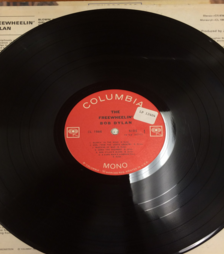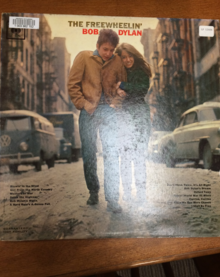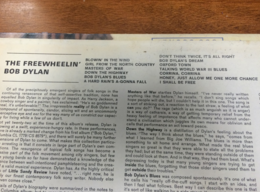

The album The Freewheelin’ Bob Dylan, released in 1963, served as a distinct catalyst for change in the civil rights movement and the antiwar movement against Vietnam. Within the record, the songs “Blowin’ in the Wind” and “Masters of War” particularly became renowned anthems for peace and equality for Americans. Unfortunately, among these famous pieces one of the most important parts of the LP recording has received little attention. The Freewheelin’ Bob Dylan not only contains a collection of powerful, protest songs, but also the physical recording album and record jacket add meaning and depth to the work because of the image portrayed on the front cover, and the Bob Dylan’s own detailed descriptions of the music given on the back.
The front of the record jacket offers a photograph of Bob Dylan and his girlfriend at the time, Suze Rotolo, huddled together walking down a city street in the cold. This quiet and simple image reflects the ideas in Dylan’s lyrics and sound–an urgent move toward peace and love and away from war and strife–that prevail throughout this collection of songs. The visual image of this cover sets the tone for the music contained inside. The quality and meaning of the album and the songs become clearer and the image enhances Dylan’s message by giving the listener a visual image of the writer at peace with himself.

The back of the record jacket offers a collection of detailed information, with paragraphs describing segments of each song’s text, why Dylan wrote the song, where his inspiration for the song came from, when he wrote the song or what he intends to express in the song. Dylan’s true passion for the civil rights movement and his hate for the war in Vietnam are amplified by his commentary. His songs protest war and support civil rights in an “ubiquitous” and “elusive” way, so this information gives clarity to the work (Dettmar 43). For example, Dylan describes his song “Masters of War” as a “song of striking out, a reaction to the last straw, a feeling of what can you do?” Dylan’s perspective allows the reader to understand his emotions, motivations, and reactions to the events of his time. He states that he generally “doesn’t sing songs which hope people will die, but I couldn’t help it in this one.” The combination of his description of the intention of “Masters of War” and the confession of his rage give the song a background that may not have been established solely by the lyrics for the listener. Furthermore, Dylan states on the description of “Blowin’ In the Wind,” “I’m only 21 years old and I know that there’s been too many wars.” This allows the listener to understand Dylan’s ideas more deeply because of the expansion on the lyrics he gives. “Blowin’ in the Wind” becomes a personal statement with a specific intention rather than just a popular song on the radio. The record is a valuable part of primary source because it makes the album deeper than just a recording by providing the perspective and insight that Dylan had writing the album.
The additional detail and meaning given by the commentary and imagery on the cover of The Freewheelin’ Bob Dylan gives a concreteness and deeper meaning to the album.
Works Cited
Dettmar, Kevin J. H., ed. The Cambridge Companion to Bob Dylan Cambridge University Press 2009 Cambridge Companions Online.
Dylan, Bob. The Freewheelin’ Bob Dylan. Bob Dylan. Columbia Records, 1963. Web.